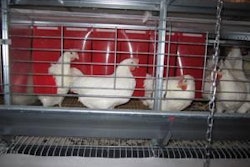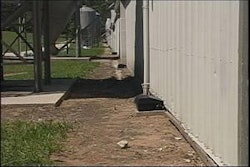
California Proposition 2, which passed in November 2008, takes effect on January 1, 2015. In essence, Proposition 2 states a bird must be able to sit down, stand up, turn around and extend her limbs without touching another bird or the sides of an enclosure, according to Jill Benson, vice president of JS West & Companies.
By January of 2015, all shell eggs sold in California will have to meet Proposition 2 requirements for rearing of the hens. The problem is that the state has not said what housing systems meet the standard.
Asking the judge
In July of 2010, JS West placed its first flock of around 150,000 hens in a purpose built house with a Big Dutchman enriched colony housing system. American Humane Certified announced that this enriched colony housing meets its science-based standards for humane housing and it can be certified. Enriched colony systems provide hens with a wide range of behavioral opportunities such as perching, nesting and dust bathing.
Because of inaction by the state of California, JS West decided that it needed to take legal steps to get a decision on whether or not its enriched colony housing systems will comply with Proposition 2. “JS West filed a lawsuit against the state of California and the Humane Society of the United States to get a declaratory judgment from the judge to say that the enriched colony barn that they built will comply come 2015,” said Benson. “The judge will not set a standard per se, but will look at the specific housing system and come to a decision on whether or not it complies with the vague verbiage of Proposition 2. The judge will also share how he came to that decision, which will allow other egg farmers to know what will comply or not.”
Benson said that JS West, which has 1.8 million layers in California, is committed to navigating its way through the regulations and uncertainty and staying in the egg business.
“We believe that California consumers will always want a California egg, and whatever that egg turns out to be, we hope to care for the hens that lay them,” said Benson. “That is why we have taken such an active role in trying to determine our future.”
Investment in the future
The enriched colony housing system gives birds more room and it takes up more space per bird in the layer house. United Egg Producers Certified standards call for 67 square inches per bird; the enriched colony system employed by JS West provides 116 square inches per bird. Benson said that the system was selected because it meets the EU layer housing requirements that take effect next year. The total cost for the house and equipment was $3.6 million.
Converting existing housing to enriched colony systems will likely require additional housing square footage to house the current number of hens. Benson said that if a producer has a deep pit house, they might be able to install two floors of enriched colony enclosures with manure belts and then might be able to house roughly the same number of birds as they did in this house with battery cages. But most producers would have to build additional houses to produce the same number of eggs when converting from battery cages to enriched colony housing.
It takes time to build new buildings and install equipment, and it isn’t just the time it takes for bricks and motor work. “Trying to get permitting today for new barns is an arduous process and sometimes unsuccessful,” said Benson. “There are so many roadblocks even in agricultural zones, particularly in the southern part of the state.” Producers outside of California who wish to sell shell eggs in the state must also comply with Proposition 2. There could be a lot of new housing built both inside and outside the state.
Comfort Coop brand
JS West sells its eggs through a marketing cooperative. The enriched colony eggs are being marketed under the Comfort Coop label. Benson said that this is being done on a limited basis since there are only 150,000 hens. She said they are working with the retailers to try and keep relatively low the price spread between Comfort Coop eggs and traditional eggs.
Benson said that JS West has been able to get a small premium for enriched colony eggs, “barely enough to cover our costs.” She said that they need to have three or four flocks through the colony house to really know what the costs are compared to regular cages, but that feed costs are higher for the colony house so far.
Operating costs
Because of the additional square footage per bird and per cage, there will always be a higher capital cost for enriched colony housing when compared to battery cage housing.
But, Benson hopes that at some point the enriched colony produced eggs will be produced at something close to the cost of battery cage eggs when it comes to non-capital input costs.
Benson is happy with how the colony housing has performed overall. “We are very impressed with what we have seen so far,” she said. One part of the colony system that could use some work according to Benson is the scratch area. There is an auger that brings a little feed over to the scratch area to entice the birds to use the scratch pad. Benson said that the feed does bring the birds over but it leads to some wasted feed. She also said that putting more holes in the scratch pad might help to keep it clean.
The hens have so much room and do so many activities in the colony cages that they are eating more, according to Benson. The combination of the increased feed consumption and feed wasted in the scratch area means more feed per dozen eggs when comparing colony and battery housed hens.


















